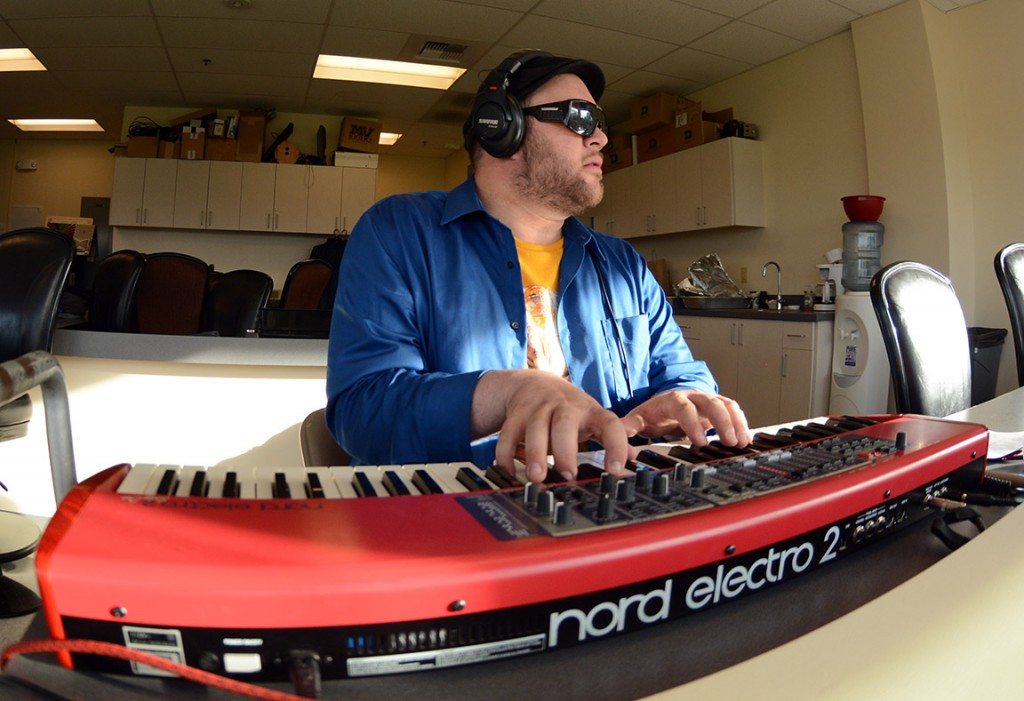
Tahoe Onstage photos by Tim Parsons
One of the city’s busiest jazz players, Tristan Selzler, added a Sunday gig at the minor league baseball stadium last season. He played organ during the Reno Aces games, a musical interlude that used to be common with America’s pastime.
“Baseball and jazz are really American things,” Selzler said before a game between the Reno Aces and Nashville Sounds. “Most stadiums don’t have them anymore. It is a nice throwback gesture.”

Tim Parsons / Tahoe Onstage
While the Aces, a Triple-A affiliate of the Arizona Diamondbacks, are comprised of coaches and big-league prospects from all over the globe, Selzler is a local product.
He moved to Reno 13 years ago to attend University of Nevada, Reno, where he earned a bachelor of arts degree in piano and a masters in improvisation. He has remained in the Biggest Little City in the World, and it’s hard to imagine anyone else being more entrenched in the music community. He was the music director for Unity Center of Reno, a progressive spiritual center, and he played in seven bands. He also helped develop JamPro Music Factory’s curriculum. JamPro is a sponsor of the Aces’ stadium organ, which also was used in the 2013 season.
The Aces are not playing live organ music in 2016.
Organ music was first played at Major League games in 1941 at Wrigley Field, the home of the Chicago Cubs. It became popular across the nation, including Dodger Stadium and the Oakland Coliseum. It was prominent in the iconic baseball movie about the minor league team the Durham Bulls.
Live organs at baseball games have become rare, and when baseball recently employed a pitch clock, lulls in the on-field action reduced the playing time for the keyboard player. Selzler said he mostly plays when the batter steps out of the box or hits a foul ball.
He said, “I stay true to the stuff you expect he hear: pop music or American folk music. ‘Charge,’ ‘The Mexican Hat Dance,’ and, if I see the umpires make a bad call, ‘Three Blind Mice.’ ”
He played songs such as “Smoke on the Water,” “Louie, Louie,” ‘Tequila,’ and some hip-hop beats by Dr. Dre and 50 Cent. And Thelonious Monk, too.
“I don’t play the whole song, but Thelonious Monk has some very distinguishable melodies. They are recognizable, especially by friends who listen on the radio.”
Selzler’s improvisation skills are important. He plays from the press box, sitting next to sports writers, television and radio crew members, the public address announcer and sound man Seth Garber, who plays the batter walk-up music, prerecorded music between innings and during between-inning contests.
“It is a little stressful because the last thing I want to do is step on an announcement or the canned music,” he said. “There are a lot of people yelling. But I have a hell of a view.”
Selzler has to wear headphones because there is a two-second delay before the sound resonates from a giant wall of speakers in center field.
Selzler said people often show surprise when they see him enter the park with a Nord Electro 2 keyboard under his arm. It can emulate sounds of a Fender Rhodes, Wurlitzer Stage Piano and a Hammond Style Draw Bar Organ.
“I didn’t know they had a live player,” said Karl Keller, who attended a game with his son, a varsity player at Douglas High School. “It gives the game a classic feel.”
Behind the third base dugout, Pamela Munk clapped to the rhythm of the organ music.
“We are very happy they brought the organ music back,” said Munk, who with her husband drive an hour and a half from Lovelock to catch about 10 games a season. “It makes the game feel more authentic and happier. It gives you that baseball feeling and brings back memories …”
“Of Dodger Stadium,” husband Jeffery interjected with a bit of sarcasm.
The Munks are a mixed marriage: Jeffery is a Giants fan, and Pamela likes the Dodgers.
“I was in love with Mike Piazza,” Pamela Munk confessed.
Guest services attendant Craig Meyer, who monitored the aisle between Sections 113-114, has been a Giants fan since the big-league team played at the Polo Grounds in New York.
“You were either a fan of the Giants, the Dodgers or the Yankees,” he said “There was no crossover, but there were mixed marriages. This stadium reminds me of Ebbets Field because the fans are so close to the field. I remember how Carl Furillo played that giant right-field wall like a harmonica.”
Meyer hadn’t noticed the organ music was live during the Sunday Aces games this season, but when learned about it, it stirred baseball memories. His uncle caught a foul ball hit by Johnny Mize at the first game he attended at the Polo Grounds. He said in 1962 he saw Willie Stargell hit the first home run at Shea Stadium, home of the Mets, and he remembered the organ music at Yankee Stadium. “It sounded just like Radio City Music Hall,” he said.
“My wife said they had an organ player at Griffith Stadium because the Washington Senators were so bad they had to have something,” he said.




